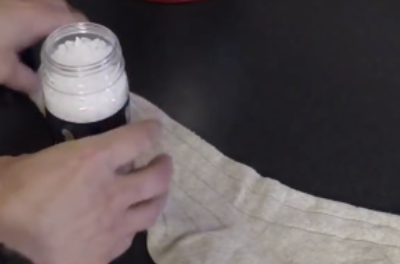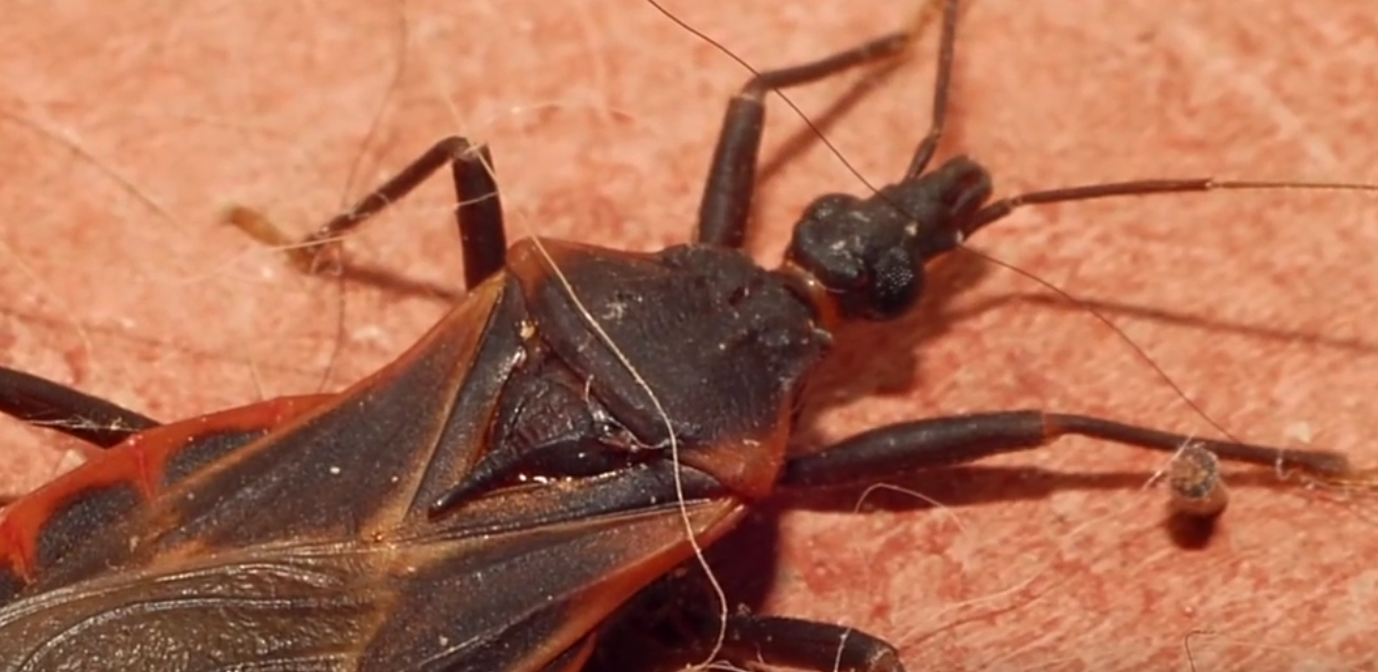He Places A Sock Filled With Salt On A Pan Heats It Then Puts It On His Ear. THIS Is The Reason Why!

image via – youtube.com
Ear infections can wreak havoc on our health and wellness. They often end up creating terrible and debilitating pain that for some people is chronic and lasts days without end. Children in particular are prone to developing them and it’s heartbreaking having to see your child suffer through the throbbing aches and pains.
Instead of enduring an earache or visiting the doctor, try this age old self-healing trick. It’s called “the magic salt sock” and all you needs is a clean, plain, all white, cotton sock and about 1½ cups of coarse sea salt. Pour the sea salt into the sock before tying it up and closing it off with a knot.
It’s vital that you use these exact two “ingredients” since no alternative versions of them will be nearly as effective. If you fail to use a plain cotton sock that is completely all white, and instead go with one that has even just a colored line on it, you’ll likely end up melting or even burning it.
There is something in the coloring which makes them highly flammable, so be aware and use caution. The sea salt also matters because of the larger sized, more coarse granules it comes in and its ability to retain heat. Regular old table salt won’t work and will just seep out of the sock, so don’t substitute it in place of the sea salt!
The next step is to warm up a skillet over medium-low heat before placing the salt sock in the pan. Allow it to heat up for about 4-6 minutes and every minute or so flip it over and shake it up so that it heats evenly all the way through. You’ll know the sock is done when it’s very warm to the touch, but not so hot that it might burn you.
Finally, all you have left to do is place the heated sock over your aching ear, making sure that it also rests on the area behind your jaw. Sit back and relax as the salt works to alleviate the aches and pains, while simultaneously helping to draw out any toxins in the ear. It’s that simple!
This is one of the best ways to naturally and effectively decrease any discomfort or inflammation in the ear that’s causing you pain. In addition to its natural healing properties, warm sea salt is also antiseptic and can draw out any moisture that may be in the ear.
Furthermore, the magical salt sock can be reused many times safely and effectively, but it will eventually discolor and you should replace it when it becomes worn, dirty, or old. Putting a cup or two of sea salt in a sock, warming it up on the stove, and placing it over your ear may be just the thing your body needs to feel better.
It’s cheap, all natural, and can be done in the comfort of your own home. Many people have found soothing comfort and relief with this simple remedy and if you ever have an ear ache or pains, give it a try and see if it works. Pass this information on to your friends and family, they may find it extremely useful and beneficial as well!
Let us know if you tried out this life hack! Enjoy the video and tutorial below!
Please Share This With Your Family and Friends
Apparently You Should Never Wear A Hairband Like THIS. The Reason Is Terrifying!

image via – youtube.com
Many girls and women are into the new ribbon hair ties that don’t leave marks when you wear a ponytail. We use them over and over again, and sometimes wear them on our wrists, in case we decide to put our hair up later. They get washed from time to time, but I can at least say for myself after watching this cautionary video, definitely not enough!!
The following footage that you are about to watch below, is told by Audrey Kopp whose story is really frightening. She had been wearing her sparkly hair tie on her wrist, as she always did when not using it in her hair. She noticed a red mark on her wrist, which she at first thought was a spider bite. It kept getting more and more inflamed and painful, which luckily got her to go see a doctor.
The unwashed hair tie had picked up bacteria, possibly in part because of the sparkly texture, which caused a really deep infection. If it had been left untreated, it could have resulted in sepsis, which would have been live threatening!
The doctor had initially given her an antibiotic, but the infection worsened, eventually requiring an emergency surgery! A surgical incision and drainage to remove the puss-filled abscess, by Dr. Amit Gupta at Norton Healthcare, is explained in the video below.
The bacteria from Audree’s hair tie had made it’s way beneath her skin into her pores and hair follicles. She, in fact, had 3 types of infection: strep, staph and gram-negative. Listen to Audree’s description of what she went through and how grateful she is that the infection was treated before “[her] body shut down…and [she had gone] into a coma”.
She and her doctor felt this was so important to share on Facebook; no one would ever dream that placing a hair tie on their wrist, which so many people do without even thinking, could have such dire consequences! Be sure to wash your hair ties regularly and keep them off your wrists!
Please SHARE this with family and friends
This Is Not a Normal Bug and They Are Showing Up Everywhere. If You Notice One Do THIS Right Away!
Image via: Youtube
Kissing bugs may sound all sweet and innocent but they’re anything but that. The nasty little things are actually parasitic and even deadly in some cases because they spread Chagas disease to both humans and animals. More and more people in South America and the US are increasingly contracting the once rare parasitic infection and it’s now estimated that over 300,000 people are currently infected in the US alone. In the state of Texas about 400 dogs have died as a result of Chagas, as dogs are among the most susceptible to the disease.
The insect responsible for all of this death and disease, Kissing bugs, are known by their scientific name “Triatomine Bugs.” They operate by biting sleeping people and animals around the eyes and mouth areas because they feed on blood. Then, when their feces comes into contact with either the bite area or a mucous membrane like an eye, they pass the parasite known as Trypanosoma Cruzi to their victim. The parasite is spread this way because it lives in the bug’s feces and that happens to be the main way in which it enters a host’s body. As if that wasn’t already nasty enough, dogs can contract Chagas in additional ways, such as by eating either the bugs or infected animal feces. Chagas isn’t only disgusting in the way that it’s spread, but also in the way that it affects its victims. Most of the time people or animals who contract the disease don’t even know they have it until it’s progressed to a later, more serious stage. In some cases it’s asymptomatic and there are no symptoms whatsoever until a sudden serious one appears seemingly out of nowhere. That’s why it’s being called the “silent killer” and people are being urged to familiarize themselves the signs and symptoms of it, which are listed below:
-swollen abdomen
-confusion, weakness
-lack of coordination
-seizures or jerky movements
-loss of appetite
-diarrhea
-depression, lethargy -increased heart rate -congestive heart failure
Many of the above symptoms are quite common for other diseases so thankfully there are tests available that can detect Chagas. When the disease is found early enough it can usually be successfully treated and any of its harmful side-effects lessened.
In addition, there are preventative measures you can take to limit your pets exposure to the bugs. It’s not just dogs who are susceptible, any animal that spends time outdoors is at risk for contracting it, especially in the southern regions of the USA. Here are several things that you can do to decrease the overall risk that kissing bugs pose to your pets:
-Remove wood, brush, and rock piles near your house or yard, the bugs prefer these areas
-Keep pets in at night since the bugs are nocturnal
-Seal up holes in window screens and cracks in crawl or storage spaces
-Elevate outdoor dog houses off the ground
-Try to place any outdoor/yard lights away from the house, they attract bugs
If you keep your house and yard clean and in line with the above points you can greatly reduce the risk of exposure to pets and yourself. Check out the video for more information on the disease and to hear Kiska’s story. She’s a sweet dog living in Texas who almost died after contracting Chagas. For Kiska it was almost too late, there’s no cure for her since her disease was detected when it was in the later stages, and so now she has to live with a pacemaker. Please share her story and pass this important information on to your friends and family. If more people are aware of it, more lives and animals can be saved, or at the very least improved.
Please Share This With Family and Friends





